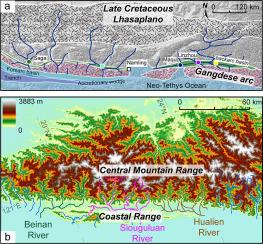IF 2.7
2区 地球科学
Q2 GEOGRAPHY, PHYSICAL
Palaeogeography, Palaeoclimatology, Palaeoecology
Pub Date : 2025-09-30
DOI:10.1016/j.palaeo.2025.113314
引用次数: 0
摘要
在印度-亚洲碰撞之前,南亚边缘的排水网络结构对于理解长期景观演变至关重要,但仍然缺乏约束。沉积学证据表明主要是河流沉积,局部受浅海影响。根据碎屑锆石UPb数据得出的最大沉积年龄限制盆地填充为~ 119-84 Ma。定量物源分析表明,大部分沉积物来自拉萨地体中北部(占41 ~ 99%),冈底斯弧贡献较少。这种物源模式与已发表的构造沉降历史相结合,支持弧后盆地模型,该模型可能是由新特提斯海洋岩石圈的回滚引发的。结合古海流测量、日喀则前弧与海沟盆地同期地层的空间对比以及碎屑锆石年龄特征,我们认为在社兴组沉积时期,有多条横向河流,而不是单一的轴向体系,沿南亚边缘切断了冈底斯弧。推断出的古地理构造可能与现代台湾相似,源自中央山脉的次平行河流穿过沉积平原,穿过海岸山脉,然后流入海洋。冈底斯弧的持续隆起随后重组了区域水系,在晚白垩世至中新世之间的某个时间从南向流动转变为轴向结构。本文章由计算机程序翻译,如有差异,请以英文原文为准。

Reconstructing paleo-drainage in southern Tibet prior to the India-Asia collision: Provenance constraints from the Shexing Formation
The configuration of drainage networks along the southern Asian margin prior to the India-Asia collision is critical for understanding long-term landscape evolution, yet remains poorly constrained. Here, we integrate sedimentological, petrographic, and detrital zircon U![]() Pb geochronological data from the Shexing Formation, deposited in the backarc basin of the Gangdese arc, to reconstruct the pre-collisional drainage system of southern Tibet. Sedimentological evidence indicates predominantly fluvial deposition with localized shallow marine influence. Maximum depositional ages derived from detrital zircon U
Pb geochronological data from the Shexing Formation, deposited in the backarc basin of the Gangdese arc, to reconstruct the pre-collisional drainage system of southern Tibet. Sedimentological evidence indicates predominantly fluvial deposition with localized shallow marine influence. Maximum depositional ages derived from detrital zircon U![]() Pb data constrain basin fill to ∼119–84 Ma. Quantitative provenance analysis reveals that the majority of sediment was sourced from the north-central Lhasa terrane (contributing 41–99 %), with only minor contributions from the Gangdese arc. This provenance pattern, when integrated with the published tectonic subsidence history, supports a backarc basin model that was likely triggered by the rollback of the Neo-Tethyan oceanic lithosphere. Combining paleocurrent measurements, spatial correlation with coeval strata in the Xigaze forearc and trench basins, and detrital zircon age signatures, we propose that during the deposition of the Shexing Formation, multiple transverse rivers, rather than a single axial system, cut through the Gangdese arc along the southern Asian margin. The inferred paleogeographic configuration may have resembled that of modern Taiwan, where sub-parallel rivers sourced in the Central Mountain Range traverse sedimentary plains and incise through the Coastal Range before discharging into the ocean. Continued uplift of the Gangdese arc subsequently reorganized regional drainage, shifting from a southward flow to an axial configuration sometime between the Late Cretaceous and the Miocene.
Pb data constrain basin fill to ∼119–84 Ma. Quantitative provenance analysis reveals that the majority of sediment was sourced from the north-central Lhasa terrane (contributing 41–99 %), with only minor contributions from the Gangdese arc. This provenance pattern, when integrated with the published tectonic subsidence history, supports a backarc basin model that was likely triggered by the rollback of the Neo-Tethyan oceanic lithosphere. Combining paleocurrent measurements, spatial correlation with coeval strata in the Xigaze forearc and trench basins, and detrital zircon age signatures, we propose that during the deposition of the Shexing Formation, multiple transverse rivers, rather than a single axial system, cut through the Gangdese arc along the southern Asian margin. The inferred paleogeographic configuration may have resembled that of modern Taiwan, where sub-parallel rivers sourced in the Central Mountain Range traverse sedimentary plains and incise through the Coastal Range before discharging into the ocean. Continued uplift of the Gangdese arc subsequently reorganized regional drainage, shifting from a southward flow to an axial configuration sometime between the Late Cretaceous and the Miocene.
求助全文
通过发布文献求助,成功后即可免费获取论文全文。
去求助
来源期刊
CiteScore
5.90
自引率
10.00%
发文量
398
审稿时长
3.8 months
期刊介绍:
Palaeogeography, Palaeoclimatology, Palaeoecology is an international medium for the publication of high quality and multidisciplinary, original studies and comprehensive reviews in the field of palaeo-environmental geology. The journal aims at bringing together data with global implications from research in the many different disciplines involved in palaeo-environmental investigations.
By cutting across the boundaries of established sciences, it provides an interdisciplinary forum where issues of general interest can be discussed.

 求助内容:
求助内容: 应助结果提醒方式:
应助结果提醒方式:


